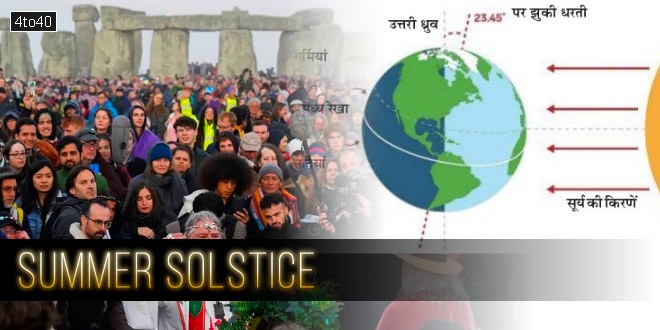What is the Summer Solstice?
The Summer Solstice is the day with the most daylight in the Northern Hemisphere. It occurs when the Earth’s axis is tilted towards the sun at its maximum angle. This means that the sun’s rays strike the Earth’s surface at a more direct angle, which results in longer days and shorter nights.
The Summer Solstice is also called the June Solstice because it usually occurs in June. Mostly, the Summer Solstice will be on June 21.
The Summer Solstice is a time of celebration in many cultures. It is often seen as a time of renewal and rebirth. In some cultures, the Summer Solstice is also associated with abundance.
The word “solstice” comes from the Latin words “sol” (sun) and “stitium” (still or stopped). This is because the sun’s path in the sky appears to stop for a brief period of time around the time of the solstice.
The Earth’s axis is tilted, which means that the sun doesn’t rise and set at the same locations on the horizon each day. As the Earth travels around the Sun, the Sun’s rise and set positions move northward or southward in the sky.
The June Solstice is significant because the sun reaches its northernmost point in the sky at this time. This is the day with the most daylight hours.
The sun’s path in the sky stops changing for a brief period of time around the time of the solstice because the Earth’s axis is at its maximum tilt towards the sun. As the Earth’s tilt begins to decrease, the sun’s path in the sky will start to move southward again.
Similarly, the shortest day of the year in the Northern Hemisphere will be on December 22, This is the winter solstice when the sun reaches its lowest point in the sky and the day is the shortest.
The opposite is true for the Southern Hemisphere. The longest day of the year in the Southern Hemisphere is December 22, and the shortest day is June 21.
Why is it called the Longest Day of the Year?
The Summer Solstice is called the longest day of the summer because it is the day with the most daylight hours in the Northern Hemisphere. In the Northern Hemisphere, the Summer Solstice typically has about 15 hours of daylight and 9 hours of darkness. In the Southern Hemisphere, the Summer Solstice typically has about 9 hours of daylight and 15 hours of darkness.
The reason why the Summer Solstice has the most daylight hours is because of the Earth’s tilt. The Earth’s axis is tilted at an angle of about 23.5 degrees. This means that the Earth’s axis is not perpendicular to the plane of its orbit around the sun.
During the Summer Solstice, the Northern Hemisphere is tilted towards the sun. This means that the sun’s rays strike the Earth’s surface at a more direct angle in the Northern Hemisphere than they do in the Southern Hemisphere.
The more direct angle of the sun’s rays means that more sunlight reaches the Earth’s surface in the Northern Hemisphere. This results in longer days and shorter nights.
The Summer Solstice is the day when the Earth’s tilt is at its maximum towards the sun. This means that the sun’s rays are hitting the Earth’s surface at the most direct angle. As the Earth’s tilt begins to decrease, the amount of sunlight reaching the Earth’s surface will decrease, and the days will start to get shorter.
Ways to Celebrate Summer Solstice
People celebrate the summer solstice in many exciting ways. Here are a few of them:
- Stonehenge, United Kingdom: At Stonehenge, a famous stone circle, thousands of people gather to watch the sunrise on the summer solstice. They believe the sun’s rays align perfectly with the ancient stones. It is a time for spiritual reflection and connecting with nature.
- Midsommar, Sweden: In Sweden, they celebrate the summer solstice with a festival called Midsommar. People dress in colourful traditional clothes, dance, and decorate maypoles with flowers and leaves. They also enjoy delicious Swedish food and drinks.
- Inti Raymi, Peru: The ancient Inca festival of Inti Raymi is reenacted in Peru during the summer solstice. It involves a lot of celebrations, music, dances, and offerings to the Sun God, Inti. The goal is to ask for a good harvest and protection for the community.
 Kids Portal For Parents India Kids Network
Kids Portal For Parents India Kids Network







